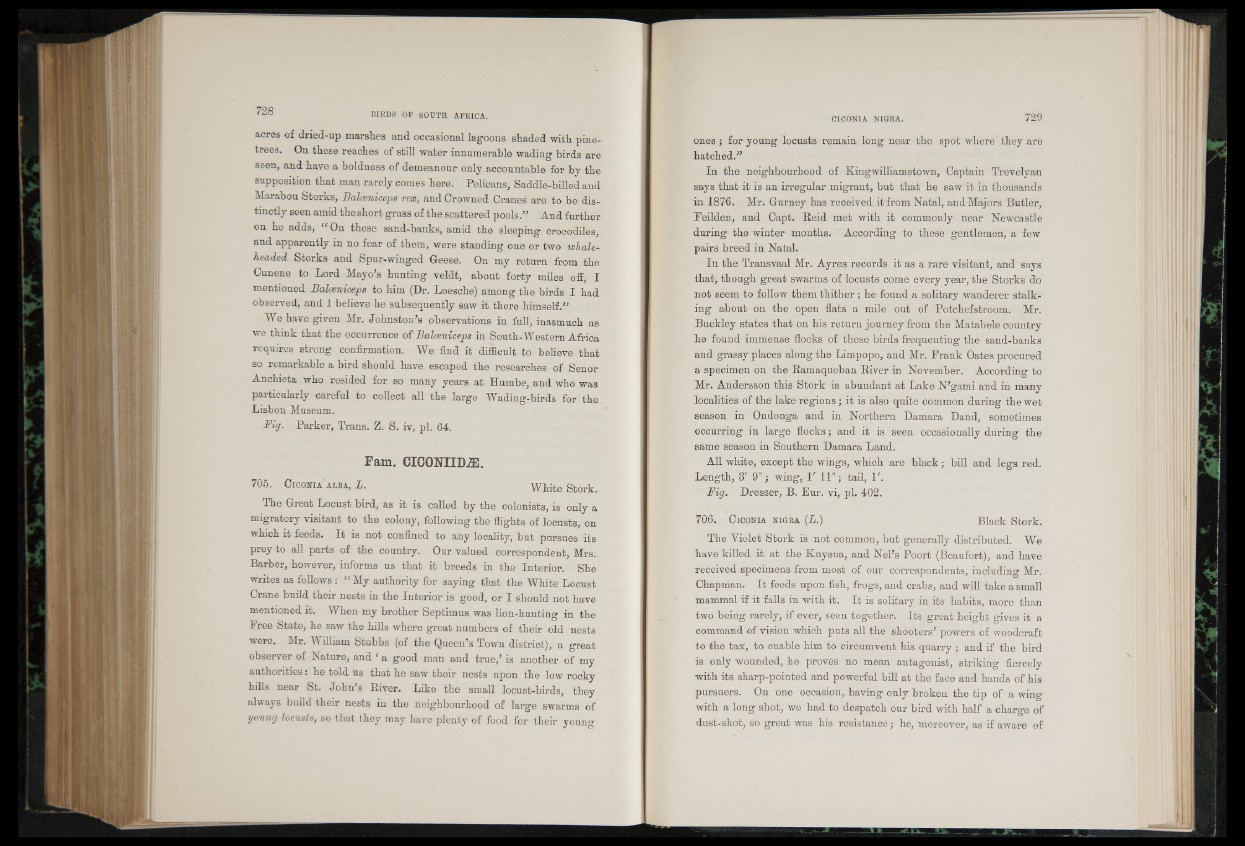
acres of dried-up marshes and occasional lagoons shaded with pine-
trees. On these reaches of still water innumerable wading birds are
seen, and have a boldness of demeanour only accountable for by the
supposition that man rarely comes here. Pelicans, Saddle-billed and
Marabou Storks, Balceniceps rex, and Crowned Cranes are to be distinctly
seen amid theshort grass of the scattered pools.” And further
on he adds, On these sand-banks, amid the sleeping crocodiles,
and apparently in no fear of them, were standing one or two whaleheaded
Storks and Spur-winged Geese. On my return from the
Cunene to Lord Mayo’s hunting veldt, about forty miles off, I
mentioned Balceniceps to him (Dr. Loesche) among the birds I had
observed, and I believe he subsequently saw it there himself.”
We have given Mr. Johnston’s observations in full, inasmuch as
we think that the occurrence of Balceniceps in South-Western Africa
requires strong confirmation. We find it difficult to believe that
so remarkable a bird should have escaped the researches of Senor
Anchieta who resided for so many years at Humbe, and who was
particularly careful to collect all the large Wading-birds for the
Lisbon Museum.
Fig. Parker, Trans. Z. S. iv, pi. 64.
Fam. CIC0NIID2E.
705. C ic o n ia ALBA, L. White Stork.
The Great Locust bird, as it is called by the colonists, is only a
migratory visitant to the colony, following the flights of locusts, on
which it feeds. I t is not confined to any locality, but pursues its
prey to all parts of the country. Our valued correspondent, Mrs.
Barber, however, informs us that it breeds in the Interior. She
writes as follows : “ My authority for saying that the White Locust
Crane build their nests in the Interior is good, or I should not have
mentioned it. When my brother Septimus was lion-hunting in the
Free State, he saw the hills where great numbers of their old nests
were. Mr. William Stubbs (of the Queen’s Town district), a great
observer of Nature, and f a good man and true/ is another of my
authorities: he told us that he saw their nests upon the low rocky
hills near St. John’s River. Like the small locust-birds, they
always build their nests in the neighbourhood of large swarms of
young locusts, so that they may have plenty of food for their young
ones ; for young locusts remain long near the spot where they are
hatched.”
In the neighbourhood of Kingwilliamstown, Captain Trevelyan
says that it is an irregular migrant, but that he saw it in thousands
in 1876. Mr. Gurney has received it from Natal, and Majors Butler,
Feilden, and Capt. Reid met with it commonly near Newcastle
during the winter months. According to these gentlemen, a few
pairs breed in Natal.
In the Transvaal Mr. Ayres records it as a rare visitant, and says
that, though great swarms of locusts come every year, the Storks do
not seem to follow them thither; he found a solitary wanderer stalking
about on the open flats a mile out of Potchefstroom. Mr.
Buckley states that on his return journey from the Matabele country
he found immense flocks of these birds frequenting the sand-banks
and grassy places along the Limpopo, and Mr. Frank Oates procured
a specimen on the Ramaqueban River in November. According to
Mr. Andersson this Stork is abundant at Lake N’gami and in many
localities of the lake regions; it is also quite common during the wet
season in Ondonga and in Northern Damara Dand, sometimes
occurring in large flocks; and it is seen occasionally during the
same season in Southern Damara Land.
All white, except the wings, which are black; bill and legs red.
Length, 3' 9"; wing, V 11"; tail, 1'.
Fig. Dresser, B. Eur. vi, pi. 402.
706. C i c o n i a n i g r a (L .) Black Stork.
The Yiolet Stork is not common, but generally distributed. We
have killed it at the Knysna, and Nel’s Poort (Beaufort), and have
received specimens from most of our correspondents, including Mr.
Chapman. It feeds upon fish, frogs, and crabs, and will take a small
mammal if it falls in with it. It is solitary in its habits, more than
two being rarely, if ever, seen together. Its great height gives it a
command of vision which puts all the shooters’ powers of woodcraft
to the tax, to enable him to circumvent his quarry; and if the bird
is only wounded, he proves no mean antagonist, striking fiercely
with its sharp-pointed and powerful bill at the face and hands of his
pursuers. On one occasion, having only broken the tip of a wing
with a long shot, we had to despatch our bird with half a charge of
dust-shot, so great was his resistance; he, moreover, as if aware of